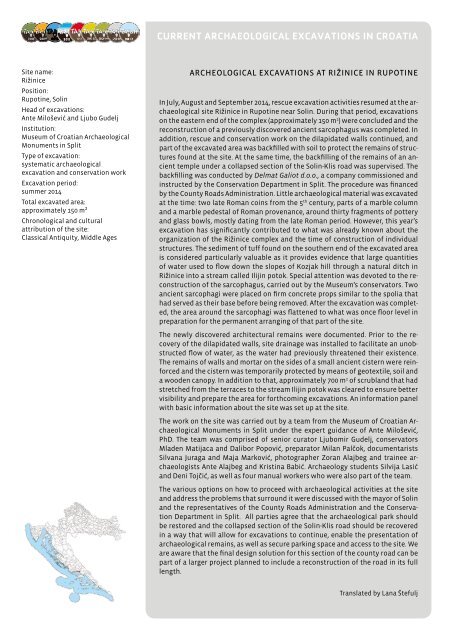AMZ_TAIUH_2017_ prijevodi na engleski
You also want an ePaper? Increase the reach of your titles
YUMPU automatically turns print PDFs into web optimized ePapers that Google loves.
CURRENT ARCHAEOLOGICAL EXCAVATIONS IN CROATIA<br />
Site <strong>na</strong>me:<br />
Rižinice<br />
Position:<br />
Rupotine, Solin<br />
Head of excavations:<br />
Ante Milošević and Ljubo Gudelj<br />
Institution:<br />
Museum of Croatian Archaeological<br />
Monuments in Split<br />
Type of excavation:<br />
systematic archaeological<br />
excavation and conservation work<br />
Excavation period:<br />
summer 2014<br />
Total excavated area:<br />
approximately 150 m²<br />
Chronological and cultural<br />
attribution of the site:<br />
Classical Antiquity, Middle Ages<br />
ARCHEOLOGICAL EXCAVATIONS AT RIŽINICE IN RUPOTINE<br />
In July, August and September 2014, rescue excavation activities resumed at the archaeological<br />
site Rižinice in Rupotine near Solin. During that period, excavations<br />
on the eastern end of the complex (approximately 150 m 2 ) were concluded and the<br />
reconstruction of a previously discovered ancient sarcophagus was completed. In<br />
addition, rescue and conservation work on the dilapidated walls continued, and<br />
part of the excavated area was backfilled with soil to protect the remains of structures<br />
found at the site. At the same time, the backfilling of the remains of an ancient<br />
temple under a collapsed section of the Solin-Klis road was supervised. The<br />
backfilling was conducted by Delmat Galiot d.o.o., a company commissioned and<br />
instructed by the Conservation Department in Split. The procedure was fi<strong>na</strong>nced<br />
by the County Roads Administration. Little archaeological material was excavated<br />
at the time: two late Roman coins from the 5 th century, parts of a marble column<br />
and a marble pedestal of Roman prove<strong>na</strong>nce, around thirty fragments of pottery<br />
and glass bowls, mostly dating from the late Roman period. However, this year’s<br />
excavation has significantly contributed to what was already known about the<br />
organization of the Rižinice complex and the time of construction of individual<br />
structures. The sediment of tuff found on the southern end of the excavated area<br />
is considered particularly valuable as it provides evidence that large quantities<br />
of water used to flow down the slopes of Kozjak hill through a <strong>na</strong>tural ditch in<br />
Rižinice into a stream called Ilijin potok. Special attention was devoted to the reconstruction<br />
of the sarcophagus, carried out by the Museum’s conservators. Two<br />
ancient sarcophagi were placed on firm concrete props similar to the spolia that<br />
had served as their base before being removed. After the excavation was completed,<br />
the area around the sarcophagi was flattened to what was once floor level in<br />
preparation for the permanent arranging of that part of the site.<br />
The newly discovered architectural remains were documented. Prior to the recovery<br />
of the dilapidated walls, site drai<strong>na</strong>ge was installed to facilitate an unobstructed<br />
flow of water, as the water had previously threatened their existence.<br />
The remains of walls and mortar on the sides of a small ancient cistern were reinforced<br />
and the cistern was temporarily protected by means of geotextile, soil and<br />
a wooden canopy. In addition to that, approximately 700 m 2 of scrubland that had<br />
stretched from the terraces to the stream Ilijin potok was cleared to ensure better<br />
visibility and prepare the area for forthcoming excavations. An information panel<br />
with basic information about the site was set up at the site.<br />
The work on the site was carried out by a team from the Museum of Croatian Archaeological<br />
Monuments in Split under the expert guidance of Ante Milošević,<br />
PhD. The team was comprised of senior curator Ljubomir Gudelj, conservators<br />
Mladen Matijaca and Dalibor Popović, preparator Milan Palčok, documentarists<br />
Silva<strong>na</strong> Juraga and Maja Marković, photographer Zoran Alajbeg and trainee archaeologists<br />
Ante Alajbeg and Kristi<strong>na</strong> Babić. Archaeology students Silvija Lasić<br />
and Deni Tojčić, as well as four manual workers who were also part of the team.<br />
The various options on how to proceed with archaeological activities at the site<br />
and address the problems that surround it were discussed with the mayor of Solin<br />
and the representatives of the County Roads Administration and the Conservation<br />
Department in Split. All parties agree that the archaeological park should<br />
be restored and the collapsed section of the Solin-Klis road should be recovered<br />
in a way that will allow for excavations to continue, e<strong>na</strong>ble the presentation of<br />
archaeological remains, as well as secure parking space and access to the site. We<br />
are aware that the fi<strong>na</strong>l design solution for this section of the county road can be<br />
part of a larger project planned to include a reconstruction of the road in its full<br />
length.<br />
Translated by La<strong>na</strong> Štefulj


